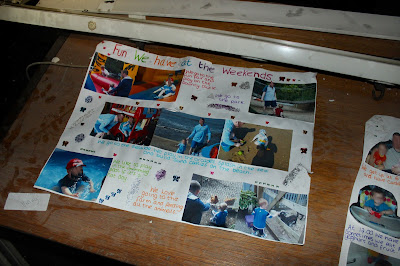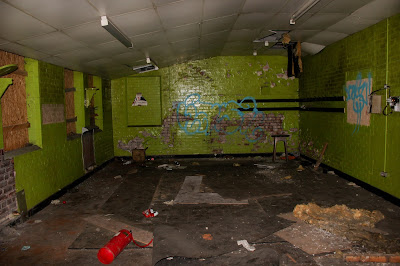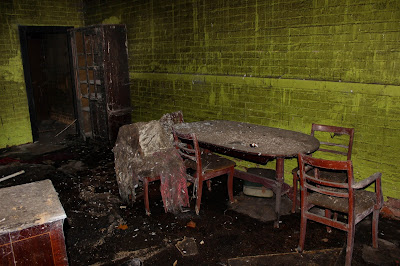(Disclaimer:
Joking aside, I fully understand the risks/dangers involved in these
adventures and do so in the full knowledge of what could happen. I don't
encourage or condone and I accept no responsibility for anyone else
following in my footsteps. Under UK law, trespass without force is a
civil offence. I never break into a
place, I never photograph a place that is currently occupied, I never take any
items and I never cause any damage, as such no criminal offences have
been committed in the making of this blog. I will not disclose location. I leave the building as I find it and
only enter to take photographs for my own pleasure and to document the
building.
I came across this place at the end of a busy day exploring. The sun was setting and I was hungry, and ideally would have preferred to sit down for a bite to eat. Nevertheless, I couldn't just turn down this big imposing building when I'm standing right here in front of it. I usually save the external shots for afterwards, because photographing abandoned buildings from the street is kinda suspicious, and if people do notice, I'd rather it be after I've snuck out rather than before I've snuck in. But with the sunlight rapidly fading I decided to risk it. Someone did give me a funny look, and it's no surprise really. This place is well-trespassed. While many an urban explorer has documented it in various stages of decay, they often displease me by copying and pasting the exact same text and calling it a day, which is boring, lazy and glosses over the true historic significance of what this place truly was.
This place was a symbol of misery when it was built.
At least before it became a coroners court, anyway. Not that discussing death is much of a mood upgrade.
It began life as a
wellfare office during the Great Depression.
The UKs export value had halved overnight, and unemployment had
skyrocketed. A lot of people were living in poverty as a result, and everything was shit. But as we all know, if there's one aspect of society that stays consistent, it's that the government will always be able to take a shit situation and make it even shitter.
Slipping inside was reasonably easy. The place is pretty fucked and it seems nobody cares about securing it anymore. But it's still evident that this was once a grand building. Immediately in front of the main entrance is this once impressive staircase. But this place has long been the focal point of the local yobs and metal thieves, and any anyone with small-dick energy who feels they have something to prove.
If one wants to get a good grasp for how shit the Great Depression was, Love on the Dole is a pretty good book, published in 1933 by Arthur Greenwood. While it's a story about a fictional family, it brilliantly captures the struggle and resilience of those affected by the challenging times, with one climactic scene being based on a real protest that Greenwood himself attended, taking place outside the town hall, which was situated right next to where this building would later be constructed in 1936.
The protest in 1931 was brought about by the governments overhaul of the welfare system. Prior to 1931, welfare was a bit more evenly distributed based on contributions from the government and employers, but now it was to be based on a case by case basis, determined by each individuals personal level of need. It sounds great on paper. The catch was, the government got to decide each persons level of need, and they weren't going to part with more money than necessary, if they could help it. So the "Means Test" was introduced as a way to evaluate a persons needs, but all too often it was more about finding reasons not to pay someone, rather than find a way to help them get by. People were denied unemployment benefits if they were
found to have savings or
household posessions that they could sell off to fund their living
expenses. Imagine being unemployed today and being denied benefits because you can just sell your sofa. It's a tad barbaric, and in the early 1930s a quarter of a million people were unfairly affected
by the means
test, losing their full unemployment pay. It's no wonder they took to the streets to protest.
Such protests were met with violent police resistance, not only on the
streets but also with unauthoritised brutality to protesters while they were in custody. One account of the event says-
"From behind the town hall, dozens of mounted police
suddenly appear and charge at us... The first engagement was fierce but
the police have tasted blood and are now lashing out at anyone in their
path... Here a mounted cop is pulled from his horse, and there a
constable deprived of his baton. But we lack the training for this kind
of fight- we have no strategy. We fight as unarmed individuals against
a disciplined armed force trained to fight as a squad. Furthermore the law
of the land is on the side of the police. They can bash us around as
much as they like and get away with it. But let one of us be caught
bashing them and we will land in the nick as sure as night follows day.
We dont need training classes to learn about the police. We have
understood their role in society since we were children running about on
the streets."
See,
I love this. It's a great primary source that reflects on the peoples
attitudes to authority at the time. It sounds fictional. It sounds almost like something you'd read in a dystopian novel, but it's genuine, and it makes mention of the
town hall, which this building would be constructed next to only a few years later. That means it happened right here. To me that's just incredible. But it also ties in to the history of this place too, albeit with a twist of irony and sadism.
In addition to that, the building is grand. More grand than it needs to be. The government was throwing its wealth
around with this place, wealth denied to those who protested. This building is a big
middle finger to the public, and a monument to their struggles.
I'm
actually a fan of protests, in that there's a wonderful energy involved
when a load of people come together to combat injustice in our society.
I've also been homeless and unemployed so I'm well aware of what it's
like to have nothing but an uncertain future, and I know what it's like
to be judged by the folks at the job centre for the crime of unfortunate
circumstances. I'm totally on the side of the protesters on this one.
Still, one can't argue that the staircase is pretty, with its iron railings. According to old photos, the orange panel next to the stairs once had a sign that said "Coroners court" with an arrow pointing up the stairs, but this has since been torn off.
The coroners court was originally held at the town hall, but that building was demolished in 1970, causing the court to relocate to this building. Specifically, to this exact room. It still has some rather fancy oak paneling and nearly half of the window panes left. With its signs of former spendor, it's easily my favourite room in the entire building.
That's right, even more so than the toilets.
Speaking of which...
As well as housing the coroners court right up until 2005, in the later part of the 20th century the building also acted as a registry office, with people getting married here in the 1970s. The local newspaper also moved here temporarily, when their building got demolished. However, it's perhaps best known in the 21st Century as being an NHS building, offering mental health support up until 2009.
This is nice. I mean, it's no surprise that it closed, because mental health support in this country is shockingly inefficient and underfunded. But it's nice that someone tried!
It's also nice for the building to have a redemption arc of sorts. As a Welfare Assistance office in the cruel 1930s it no doubt contributed to the mental health issues of the townsfolk, the descendants of which now came here to have support.
Unfortunately the offices up here are completely trashed.
Downstairs there was also a walk-in clinic from 2004 til 2011, which handled various other forms of healthcare, but while the building is said to have been vacant since 2011, one source claims that in 2013 it was used to produce a talking newspaper for blind people. It's said that during this time, the building was starting to show its age, with crumbling plaster on the walls, and cracked skylights.
This seems to be the reason why the building was eventually left vacant, but there seems to be a future for it still. In 2017 it was sold for £790k with plans to be converted into 71 apartments, fifty of which will be two bedrooms. The developers are ambitious, wanting to add three more floors. It sounds... alright, I guess.
I usually object if places of recreation get demolished to make way for housing, but I think this place has outlived its purpose. It was a welfare office, a coroners court, and a clinic, all of which still exist elsewhere in plentiful amount. The community isn't losing anything from this places conversion into homes.
There's a staircase here leading down into the cellar. I did attempt to get down there, but it's so full of rubble and clutter, doing so was pretty impossible. And if you're a long time reader, you'll know there is seldom a staircase that's impossible for me to traverse. I've climbed staircases that have no stairs. Trust me when I say this couldn't be done.
In the walk-in centre part of the building, there was a childs height scale on one wall, but also these weird posters made seemingly for the benefit of a small child and their father. I've censored the faces of the child and father, because I think that's appropriate, and I'll only be showing one of the posters, featuring their weekend extravaganza.
The second sheet was talking about their daily routine and I won't be posting it even with their faces blurred because it seems way too intrusive. It does seem sloppy of any service to leave these behind, but I also have to wonder what kind of service would make these? Making a pictoral account of a daily routine might be indicative of supporting a child with autism, but thats entirely speculative. I don't know.
Finally, we'll look at the best part of any abandoned building, the toilets.
I know I say that every blog post, but in this case, aside from the court room and fancy staircase, these toilets actually are one of the highlights of the building, because they have these cool little murals.
Here's one of a small girl blowing bubbles.
There are planes on the one wall of the boys toilet.
It's all still in better condition than the toilets in some pubs and clubs. The fact that they seem to be catered to children is interesting, and ties in with those posters about the child and their dad. Clearly this place also offered some sort of child service too. Perhaps it was a daycare centre at some point.
But that's really all I got for the place. As an urbex spot it's really more one to do when you're in the area. Don't come here just for this. It's good for beginners, but if you are a beginner then you can do better. If you do go here, wear good shoes because 90% of the time you'll be standing on rubble and glass. Structurally the building seems to be pretty good. It's not my favourite, but having never done a coroners court, I'm glad I struck that off my list.
That's also it for this part of the country. My next couple of blogs will be in Shropshire, and they'll be a nursing home and my very first peek at some freakin' mines. I'm very excited for that. In the meantime, follow my Instagram, my reddit, my Vero, and if you like looking at no updates whatsoever, my Twitter, and if you like torturing yourself with algorithmic hellscapes and have a Facebook, by all means follow my page there too.
Thanks for reading!










































































